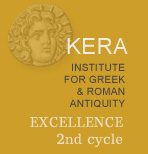The Sebasteion
In the 1960s, a number of bronze sculptures, among them some statues of outstanding quality, appeared in the antiquities trade in the United States. The pieces were said to have originated from a single location in the eastern Roman Empire, which was initially assumed to be a temple of the Imperial cult in Pisidian Kremna. But newer studies by the Turkish archaeologist Jale İnan, and the surfacing of diaries belonging to a treasure hunter, have subsequently established the origin of the most important group among those sculptures to be a structure on the main site of Boubon (İnan 1979, 1993, 1994). In 1967, after a bronze torso unearthed by looters had come to the attention of the municipal authorities, the archaeological museum of Burdur undertook the first legal excavation at the site. During the course of that excavation, there was brought to light a structure situated near the centre of the terrace above the agora, which appears to have been a municipal shrine for the Imperial cult, and so became known as "the Sebasteion": a north-south oriented room, its entrance apparently at the south, measuring 6.50 meters in length and 4.80 meters in width.
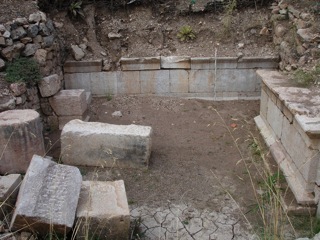
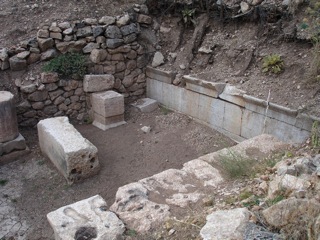
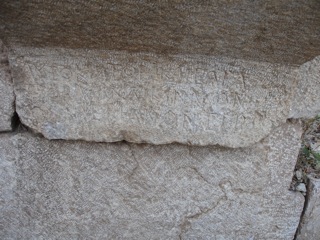
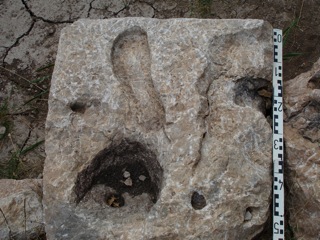
Two inscribed podiums, in situ along the north and the east walls of the room, and four free-standing bases (A-D) found along the west wall attest the existence at some time of statues of emperors and members of the Imperial household. After excavation, the building was again buried. The inscriptions were subsequently published, by C. P. Jones (1979), on the basis of majuscule copies and photographs. At the same time, İnan undertook to combine the dedicatory inscriptions found at the Sebasteion with some of the bronze pieces that were by now in various collections (İnan 1979).
Following these initial investigations, questions remained concerning the inscriptions and the reconstruction of the podiums--in particular, the arrangement of the statues within them--and the building was therefore excavated a second time, in 1990, by İnan on behalf of the museum in Burdur. Since that time, the building has not been reburied, and is now accessible to visitors. İnan's latest studies (1993 and 1994), in combination with Jones' earlier publication (1979), represent the current state of research on both the epigraphy of the Sebasteion and its connection to the bronzes unearthed there. These publications draw on and update the corpus of inscriptions by Schindler (1972) and İnan's first published discussion of the inscriptions and statues (1979).
As a result of the second series of excavations, it became clear that the room was not an independent structure but was flanked by two similar rooms at its east and west (İnan 1993, pp. 215-216). To judge from its layout, the room might have belonged to a portico. A connection of a sebasteion with a portico is known from Narona in Dalmatia, and is possibly attested in Cilician Cestros and in Choma, in northern Lycia1. Excavation of the surrounding structures will be needed to determine the relationship among these rooms. One of the inscriptions on the north podium suggests that the room was dedicated in the reign of Nero (no. 9). The use of the structure appears to have extended to the reign of Gallienus in the middle of the 3rd century CE.
İnan's study of the sculptural décor of the Sebasteion, and in particular of its several ancient rearrangements, is based on an association of extant and lost statues with the inscriptions on the bases. İnan assigns seven known bronzes a place in the Sebasteion, based on seven of the fourteen dedicatory inscriptions found in situ in the room. Unsurprisingly, some of the Imperial bronzes that were set up in this room have been lost. Notable among these were statues of disgraced emperors and short-lived members of their households, which were removed in antiquity as a result of Imperial politics . Finally, İnan suggests that most of the remaining statues were relocated at some point, to make room for more sculptures. Her proposed reconstruction is generally convincing, but it falters in part on the assumption that changes in the arrangement of the statues are documented by observable changes in the epigraphic texts, i.e., erasures and the effacement and re-engraving of some of the words. It is possible, however, that paint or plaster might also have been used to alter the texts2. In addition, a strict correlation between the survival of a text and an associated statue cannot be entirely certain; for example, the preservation of an inscription in honour of Poppaea Sabina, wife of Nero from 62 CE, does not provide secure evidence that her statue remained in place, two centuries after that of her disgraced husband had been removed. Inan’s reconstruction of the sculptural display in the Sebasteion provides, nonetheless, a useful working hypothesis in anticipation of further study of the bronzes3, and the following overview of the sculptures of the Sebasteion is based largely upon her findings.
The room seems to have served the purpose of honouring members of the Imperial family for a period of over two centuries, roughly from the middle of the 1st to the middle of the 3rd century CE. Initially, it must have contained a statue of Nero and, to his right, one of his second wife, Poppaea Sabina. To judge by the position of the extant dedicatory inscriptions on the north podium , the two statues apparently stood at the northwest corner of the room, on the far left of the north podium rather than at its center, and hence were not positioned immediately opposite the south entrance . Consequently, in this early phase, there apparently was room on the podium for other sculptures. If the building, from its inception, was dedicated exclusively to the worship of the Roman emperors, it is unlikely that the remainder of the podium would have been left free of sculpture, even in anticipation of later Imperial additions, since the relegation of the statues of Nero and Poppaea Sabina to one end of an otherwise empty podium would have been a remarkably negative statement about Imperial rule. It is much more likely that the statues of Nero and Poppaea Sabina were joined on the podium, from the start, by others, probably statues connected with Nero’s public image4 or statues of a god. Hence the statue of the reigning emperor would have been given a prominent position in a new shrine devoted to the Imperial cult. If, on the other hand, the building was not initially dedicated to Imperial cult, the position of the statues of Nero and Poppaea Sabina might suggest that the building was dedicated to the worship of a god. In this case, Apollo would be an obvious candidate, given Nero’s self-identification with the sun god, and the podium would have been shared with statues of Apollo and perhaps also other sculptures evoking Nero’s public image.
Nero's statue was removed after his death in 68 CE, in consequence of his having been declared an enemy of the state by the Roman senate. Also at some time after his death, his name was erased from the inscription on the podium below the statue , which was apparently also the dedicatory inscription of the building (no. 9). If indeed Poppaea's statue remained in place at this time, it appears on the grounds of the preserved inscriptions to have shared the podium with Domitian until his memory was damned in 96 CE (Jones 1979, pp. 291-292). Between 96 and 98 CE, the statue of Poppaea Sabina found a new partner in the statue of Nerva, which was now erected in place of that of Domitian. According to Inan's reconstruction, the statue of Nerva was at a later time placed still closer to that of Poppaea Sabina to make room for statues of Marcus Aurelius and Lucius Verus. In Boubon, then, it seems that the dazzling beauty who, in life, had abandoned Otho to marry the young emperor Nero, ended up at the side of the aged Nerva, whom she had undoubtedly once known among Nero's courtiers. On the presumption that the pairing of Poppaea and Nerva is not a demonstration of Boubonian humour, an explanation must be sought for the preservation of Poppaea's statue for so many decades, and even centuries, in an architectural context in which apparently there was no space to spare.
Even as a declared enemy (hostis) of the state, Nero the imperator scaenicus remained widely popular in Rome and in the provinces after his suicide5. Hence, the removal of Nero's name from the inscription on the podium under his statue may have been more an action in favour, or in fear, of L. Licinius Mucianus than one aimed directly against the dead emperor. Mucianus, identified in the dedicatory inscription of the Sebasteion as the provincial governor of Lycia under whose auspices the dedication to Nero had taken place, had subsequently governed the province of Syria, and he played a crucial role in the Flavians' accession to power in 69 CE. It is not hard to imagine that those responsible for the sanctuary wanted Nero's name erased from the inscription at the Sebasteion when Mucianus was making his way through Asia Minor, from Syria to Rome, to secure the throne for Vespasian. Such local concerns may also have guided the preservation of the statue of Poppaea Sabina, if we imagine that those who had paid for these costly statues--most likely a number of prominent Boubonians, either independently or supported by the governor--would have been reluctant to eliminate her portrait along with that of her husband.
Imperial statues continued to be installed in this room over the course of the 1st and 2nd centuries, though some of the most important emperors appear never to have been honored here. According to Inan, the Flavians were represented only by Domitian. Nerva's statue is followed by a chronological gap of more than half a century: there is no trace of statues for Trajan, Hadrian, or Antoninus Pius6. The next emperors to be honored in the Sebasteion of Boubon appear to have been Marcus Aurelius and Lucius Verus, whose statues are the earliest that are preserved to us. The last Antonine, Commodus, received an over-life-sized statue that was placed at the east end of the north podium, possibly with Bruttia Crispina to his right. Because Crispina, married to Commodus in 178 CE, was exiled in 192 CE, and then killed and disgraced, the presence of her effigy would likely have been short-lived. The statue of Commodus remained and has survived to our day. It is considerably larger than those of Marcus Aurelius and Lucius Verus, and this distinction in size is an argument against a reconstruction of a statuary group composed of Marcus Aurelius, one of the smaller statues; his sons, including the large statue of Commodus; and his daughter-in-law Bruttia Crispina. Another argument against such a grouping is that the death of Lucius Verus in 169 CE preceded the marriage between Bruttia Crispina and Commodus. Commodus' statue was most likely set up after the death of Marcus Aurelius in 180 CE.
On the evidence of the inscriptions, a statue of the first Severan emperor was included in a group with his wife and sons. Originally, the Severan group appears to have occupied the entire east podium and to have included Geta and Caracalla standing among Septimius Severus and Julia Domna (nos 14-17; Jones 1977, p. 292). Of these statues, those of Severus and the young Caracalla survive. If there was an inscription in honour of Geta, it would likely have been erased after his damnatio memoriae, which was possibly in 211 CE. Presumably in order to make room for a statue of Gordian on the east podium, the statue of Septimius Severus was later removed from the east podium and set up on the north podium next to the statue of Commodus, which was then moved further to the west, possibly into the position left vacant by the elimination of Crispina's statue.
About a decade after Gordian's death, his statue was moved to a separate base (C) against the west wall, to make room on the east podium for another Imperial group, which included Valerianus I, his son Gallienus, and Gallienus' wife Cornelia Salonina. From those statues, a torso identified as that of Valerianus has survived. Our remaining evidence of Imperial inscriptions and statues includes base D, with an inscription honoring Caracalla as sole emperor (no. 17), and a head and torso that have been assigned by İnan to this base. This, Caracalla's second statue in the Sebasteion, stood against the west wall of the room, next to the statue of Gordian . The evidence for whether pilaster A (which included a stone with a Hellenistic inscription in reuse), and base B, which is uninscribed in its present condition, were statue bases is inconclusive.
If this room was the Sebasteion of Boubon, and if the preserved inscriptions dependably reflect the sculptural program of the room, as İnan assumed, it is difficult to explain the choice of emperors represented here. A possible explanation is that the sanctuary consisted of more than one room. If that is so, then the selection of sculptures installed in this room may have been a consequence of arrangements or rearrangements carried out in other rooms. The absence, for example, of a statue of Antoninus Pius among the Antonines here may have been due to its erection elsewhere in the building. Another possible explanation of unexpected omissions is that this collection of Imperial statues in Boubon was made up of donations from the incomplete collections of private individuals. Such a collection is described in Ep. 10.8, where Pliny the younger speaks of Imperial statues in his possession that he had inherited from various persons over the years (per plures successiones traditas mihi) and that he had kept at his estate near Tifernum Tiberium. He had at one time received permission from Nerva to add a statue of that emperor to his collection and to transport the statues to town, where the local magistrates had agreed to assign land for a temple to be built at Pliny's expense7. Surely no statue of the last Flavian was contained in the collection of statues that Pliny offered to set up in the new temple of the Imperial cult in Tifernum. For although Pliny had served in a high position under Domitian, his period in that position had been followed by the official vilification of Domitian, as well as by Pliny's sustained efforts to portray that emperor as a tyrant and as the direct opposite of Trajan and his "father" Nerva. Pliny’s distancing of himself from Domitian was also among his personal concerns, his way of dissociating himself entirely from his own past8.
The influence of such powerful private individuals upon civic bodies could have resulted in the familiar merging of private and public initiative. Pliny, the confidant of emperors, fulfilled the role of a local magnate in Tifernum. While he offered the statues and the financing for the building of a temple of the Imperial cult, the city chose the spot and assigned the land. The seemingly random or, at best, selective collection of Imperial bronzes at Boubon is more easily explained as the result of such private initiatives authorized or endorsed by the polis than as a sculptural program aimed at representing the statues of every emperor from Nero to Gallienus and for some reason failing in that attempt. Further evidence may alter this conclusion.
According to Inan's reconstruction, then, a visitor to this room in its latest ancient arrangement, in the middle of the 3rd century CE, would have seen bronze statues of Poppaea Sabina, Nerva, Marcus Aurelius and Lucius Verus, Commodus, and Septimius Severus on the podium facing the entrance. On the podium to its right stood statues of Julia Domna and the young Caracalla, Salonina, Gallienus, and Valerianus, and to its left, a statue of Caracalla as emperor, one of Gordian, and possibly one or two more Imperial effigies. Seven of those statues survive today, in various states of preservation, the earliest representing Marcus Aurelius and the latest possibly representing Valerianus.
Sculptures in bronze were usually expensive, high-quality artefacts, and the torsos and fragments surviving from the Imperial bronzes in Boubon suggest that these bronzes were no exception. In contrast, the quality of the inscriptions on the bases and podiums under those statues ranges from mediocre to poor, a judgment as true for the inscription for Nerva as for those of the 3rd-century emperors. Other inscriptions found in Boubon, for instance the statue bases inscribed with honorary texts, rise to the usual standard for the region in the 1st and 2nd century and attest the availability of qualified stone masons to Boubon. It is conceivable, however, that access to the sanctuary for purposes of carrying out modifications was more limited than to other areas of the site, restricted perhaps to members of a family or collegium, and that masons were thereby excluded9. Alternatively, the surviving statues may have been in reuse in the Sebasteion, reflecting the artistic level--and possibly the civic finances--of a different period in the history of Boubon from that to which the extant inscriptions belong. Though this author is unqualified to offer a final judgment on the dating of sculptural artwork, at least one of the statues looks as if it could well be of Hellenistic date (cf. Queyrel 2003, pp. 117-118). Finally, if this room was only one in a larger complex of rooms, the low quality of the inscriptions may be a consequence of the statues’ relative unimportance at the time when they were moved into their secondary positions. Some of the extant inscriptions may even have been copies of earlier inscriptions, carved as late as the 3rd century in poor imitation of their originals.
Additional examples of bronzes that possibly originated from Boubon, briefly mentioned by İnan (1993, pp. 236-237), await further interpretation and publication. These include a bust mentioned in the unpublished diary of the treasure hunter M. Çömbül as having been found along the road leading from İbecik to Dikmen/Boubon and a number of pieces that, together with the Imperial statues, surfaced in the United States in the 1960s.
1 Narona: Marin 2004; Cestros: Bean and Mitford 1970 pp. 155-160; Choma: TAM II 905, cf. Kokkinia 2000, no. XIX C 4. Municipal places of Imperial worship: Witschel 2002, especially pp. 120-121 (Boubon). A sebasteion belonging to a portico has been newly excavated in Macedonian Kalindoia (Σισμανίδης 2007).
2 On the possible use of plaster to cover the name of a disgraced personality, see Flower 2006, p. 193.
3 See recently Queyrel 2003 , pp. 117-118.
4 Champlin (2003).
5 Flower (2006) pp. 197-233.
6 Unless a head of Antoninus Pius in Edinburgh does in fact originate from the Sebasteion, as Price (1984, p. 264) suggests.
7 Pliny also records that Trajan allowed him to add a statue of him to those of the deceased emperors and to leave Rome for a month (he was prefectus aerarii Saturni at the time) to tend to this and other matters (Ep. 10.8.4 and 10.9).
8 See now Flower (2006) pp. 262-271.
9 Such restriction of sanctuary access is not known to me from any example in the Greek East, but the case with the fratres arvales in Rome may offer an analogy. On the close connection of the fratres arvales with the Imperial cult, see Scheid 1990, Edelmann 2003.
